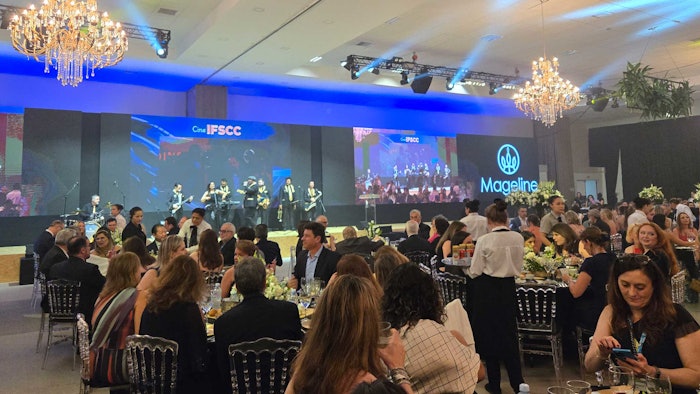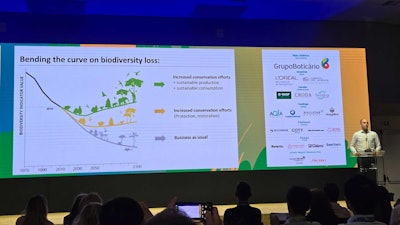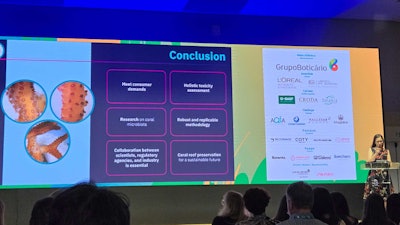
Something smelled "funny" during the opening keynote on Day 3 of the IFSCC 2024 Congress, held Oct. 14-17, in Iguazu Falls, Brazil. Fujihiro Kanda, Ph.D., of Mukogawa Women´s University, Japan, posed the question of whether to smell or not to smell. He delved into the industry's "arsenal of wisdom to combat body odors” — a theme we've seen rising interest in, as the growing market for body deodorants indicates.
Additional themes throughout the technical talks and posters ranged from solutions for rosacea, inflammation and sensitive skin; and hyperpigmentation, low oxygenation, etc., signs of aging; to UV protection, "happiness" pathways, a low-water hair conditioner, sensory testing, the skin microbiome, a photosensitive delivery system, urine-derived stem cells for personalized skin care, and even pet care. The third and final day of the IFSCC Congress wrapped up with an exclusive gala dinner and awards ceremony, sponsored by Mageline. Following are highlights.
Compromised Skin: Rosacea, Inflammation, Sensitivity, Photoprotection, Exosomal Actives Delivery, Fermented Tea Seed for Dryness
Michelle Sabrina da Silva, of Medcin, presented on the effects of a polyglutamic solution on modulating the biological parameters of rosacea ; e.g., inflammation, hypervascularization and sensitive skin. In relation, Zuxuan Zheng, of CosMax, described the development of emulsifier-free formulations suitable for sun protection for sensitive skin by reducing skin penetration.
Ji Soo Ryu, of Cosmecca, offered an exosomal approach for anti-inflammatory therapy fusing Hydrangea macrophylla leaf extracellular vesicles for effective ingredient delivery. And, Bing You, from the PeiLai Group, highlighted a study on the mechanism of action and efficacy of fermented tea seed oil to improve dry and sensitive skin.
Anti-aging: Hyperpigmentation in Different Skin Tones, Cyclic Peptides, Inflammatory Aging, Nano Phytosome, Red Jasmine Polypeptide Antioxidant, Oyxgenation in Skin
On the anti-aging front, the keynote by Cristina Garcia, Ph.D., of L´Oreal LATAM, described managing hyperpigmentation concerns in the context of skin tone diversity, providing a look at mechanisms and solutions. Laetitia Cattuzzato, from Clariant, looked beyond retinoids to a natural cyclic peptide for safe and efficient dual action against skin aging. In relation, Edson Katekawa, of Chemyunion, explored tetrapeptide-111 to slow the signs of aging, while Junxiang Li, of Harvest Biotech, discussed the computational design of a novel cyclic peptide and explored its effect on reducing skin inflammatory aging by blocking HMGB1 (high mobility group box 1), a protein associated with damage.
Usha Sundralingam, from Monash University, investigated the mechanism of action of the Geraniin anti-aging nano-phytosome. Tao Zhang, from Better Way, highlighted novel polypeptides derived from red jasmine rice bran with anti-oxidation and anti-aging benefits. Finally, Florante Ricarte, from Coty, examined oxygenation for skin rejuvenation in a study of the age-related decline of skin oxygen levels; and the efficacy of a plant-derived oxygen delivery technology.
Psychodermatology, Wellness, 'Happiness' Pathways
Kan Arai, of Shiseido, presented skin as a "mirror of the mind" and how a multisensorial skin care regimen can bring higher self-awareness for well-being. Also, Richard Leroux, from SEQENS Personal Care, proposed a marine bioactive megasugar to activate “happiness” signaling pathways and improve skin appearance.
Advances in Delivery: Photosensitive Caffeic Acid Liposomes
According to Jie Kong, of Pechoin, the combination of photosensitive carriers and natural ingredients can enhance the technological aspects of cosmetics, providing consumers with novel safe and effective skin care experiences. She therefore proposed photosensitive liposomes with caffeic acid phenethyl ester (CAPE) as a membrane structure for cosmetic applications.
More specifically, her work described the development of CAPE and CAPE-SH-CHOL (CAPE + sulfhydryl group + cholesterol) liposomes, which were prepared and encapsulated with GHK-Cu, then irradiated with natural and UV light. Per Kong, after irradiation, the liposomes had a reduced particle size and uniform distribution with high encapsulation and photocontrolled release.
"Natural light was milder than UV but still triggered changes in the liposome properties. Also, the amount of release was positively correlated with the change of liposome particle size. This is due to the properties of the the cinnamate ester group," she explained. "We will keep exploring the photosensitive release benefits for potential applications in sunscreen and skin care," Kong added.
Tech in Beauty: Data-driven Bioingredients, Bioactive Discovery
Lucas Pedersen Parizzi, from Natura, spoke on a data-driven pipeline for the efficient development of bioingredients assisted by omics, bioinformatics and AI technologies while Kyung-Jin Jang from Outer Biosciences, highlighted a next-generation human skin platform for bioactive discovery. Notably, AI and machine learning was present in various presentations, including one poster on clustering cosmetic product claims to find white space in the market.
Hair Care: Claims Substantiation, Sustainable Conditioning
 Fernanda Trombetta, of Dow, described how hair tresses treated with a concentrated conditioner dried naturally were more aligned than untreated hair. The conditioner could also be applied at one-third of the traditional dose with equal efficacy.
Fernanda Trombetta, of Dow, described how hair tresses treated with a concentrated conditioner dried naturally were more aligned than untreated hair. The conditioner could also be applied at one-third of the traditional dose with equal efficacy.
In the hair care sector, Paola Perugini, of the University of Pavia, sought to revolutionize hair claim substantiation using an advanced technology for "multiparametric 'in vivo' evaluation." In addition, Fernanda Trombetta, of Dow, described a concentrated multifunctional rinse-off and leave-on conditioner for straight and curly hair with sustainable benefits related to water and energy consumption.
Per Trombetta, hair tresses treated with the conditioner dried naturally were more aligned than untreated hair. The conditioner could also be applied at one-third of the traditional dose, which still provided:
- comparable texture (even without waxes),
- comparable spreadability during product use,
- effective conditioning, smoothness and slip in rinse-off formulas and
- additional curl definition and frizz and volume control.
- At the same time, requiring 2/3 smaller packaging than the conventional size.
Sustainability: Maintaining Biodiversity, Validating Reef-safe Claims, Regenerative Agriculture ...
 Quoting Charles Dickens, Antonelli noted, "It is the best of times and the worst of times," highlighting how far science has come but in the meantime, how climate change is drastically impacting biodiversity.
Quoting Charles Dickens, Antonelli noted, "It is the best of times and the worst of times," highlighting how far science has come but in the meantime, how climate change is drastically impacting biodiversity.
During their sustainability keynote lecture, Alexandre Antonelli and Prof. Monique Simmons, of Kew Botanic Gardens co-presented on protecting sustainably using our planet’s biodiversity. Quoting Charles Dickens, Antonelli noted, "It is the best of times and the worst of times," highlighting how far science has come but in the meantime, how climate change is drastically impacting biodiversity. "We are too dependent on too few species," he added.
Simmons underscored how Kew's work has collected some 50,000 DNA and tissue samples, and added some 46,000 species' seeds in the Millennium Seed Bank. She explained how Kew is one of the few banks that analyze the samples collected, including authenticating them by analytical chemistry.
She shared a few examples of common issues found, e.g., with acemannan in aloe; namely bacterial fermentation, chemical degradation and adulteration with maltodextrin. Also, in the case of ginseng, 24% of 507 ginseng-containing products sold in 12 countries were reported as adulterated.
 Natália de Albuquerque Vita, from Grupo Boticário, outlined the development of a RGB-based methodology for accurate validation of reef safe claims.
Natália de Albuquerque Vita, from Grupo Boticário, outlined the development of a RGB-based methodology for accurate validation of reef safe claims.
Natália de Albuquerque Vita, from Grupo Boticário, outlined the development of a RGB-based methodology for accurate validation of reef safe claims. As background, she explained how rising sea temperatures are affecting coral reefs and emphasized that the death of coral reefs can impact humanity. In addition she underscored how companies making reef-safe claims are being hit with lawsuits due to the absence of a definition or measurement for what constitutes a "reef-safe" product. Her work sought to identify such by incubating commercial coral with various sunscreen samples. Interestingly, her studies found a few isolated instances where sunscreens seemed to impact coral.
Tatiana M. Kumayama, of Ashland, unveiled a peptide-rich cocoa extract derived respecting South American Biodiversity Preservation. Also, a keynote by Desiree Schuck, Ph.D., from Grupo Boticário, explored high-impact alternative methods in cosmetic innovation. In relation, Delphine Bouvier, of L'Oreal, presented a Field Cultivation Index for assessing agricultural practices' sustainability and moving toward regenerative agriculture in cosmetic supply chains.
Sensory Testing in Pet Care
Among several other talks in "their own" category, one that perhaps stood out the most was that of Luana de Oliveira Hoffmann, from Grupo Boticário, who discussed the sensory evaluation of performance in pet products (for dogs and cats) using the animal’s synthetic "stink" and dog hair strands.
Gala Dinner and Awards
The IFSCC 2024 Brazil Congress closed with a gala dinner and awards ceremony, sponsored by Mageline, featuring the official "changing of the guard" to the new incoming IFSCC president, Prof. Vania Leite, Ph.D., followed by poster and podium award presentations, live music, dancing and a caipirinha or two.
The awards included:
- The IFSCC Johann Wiechers Poster Award, which is presented to the best poster presentation at the IFSCC Congress. This year's winner is Tomoyuki Iwanaga, of POLA Chemical Industries, Inc., for the work: "Mirror skin" generated from cells in one's own urine: A perfect skin replica for the ultimate personalized cosmetics. More specifically, induced pluripotent stem cells (iPSCs) were isolated from urine samples collected non-invasively that expressed the inherent characteristics of the donor's skin, such as inflammatory response to UVB. This could be used as a model to develop personalized products targeting specific characteristics.
- The IFSCC Basic Research Award, given to the presenter of the best podium presentation pertaining to basic cosmetic research, went to Daigo Inoue, of Shiseido, for the work: Melanoaging: Uncovering and resolving an age-spot specific metabolic change and cellular senescence caused by excessive melanin deposition.
- The IFSCC Applied Research Award honors the presenter of the best podium presentation pertaining to applied cosmetic research. This year's award went to Fumiyoshi Ikkai, of L'Oreal, for the work Red light reflection of ultramarine blue: Impact on skin-enhancing effect when used in cosmetics.
The next IFSCC Congress will be held Sept. 15-18, 2025, in Cannes.










